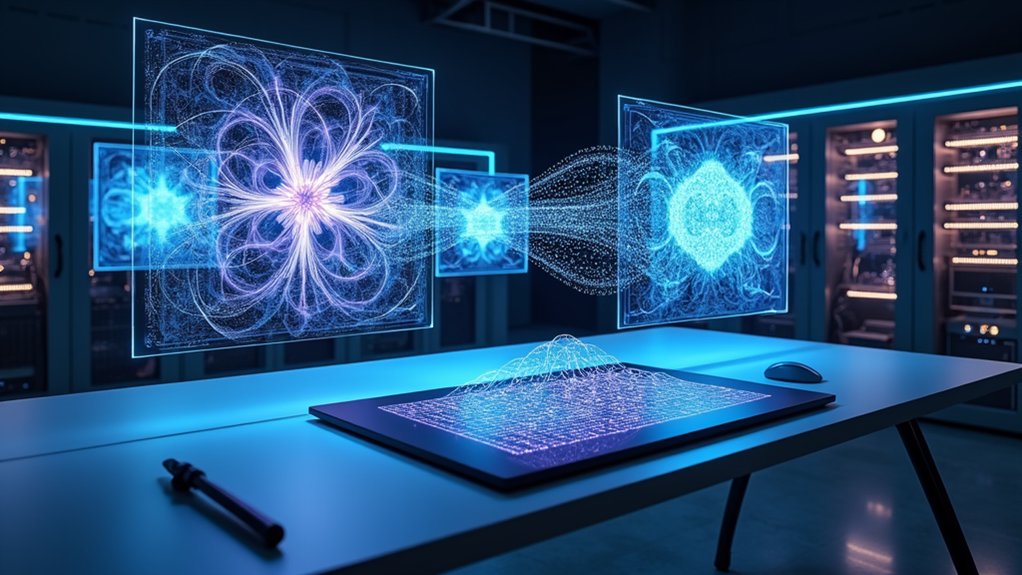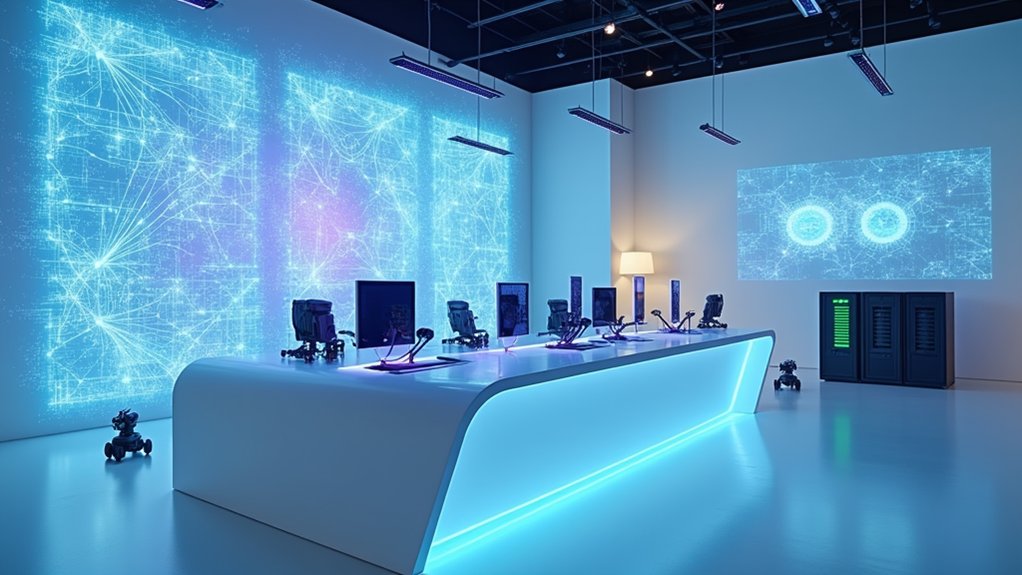AI art generation represents a significant opportunity for small and medium-sized businesses to compete with larger enterprises in creating professional visual content. While enterprise companies invest heavily in traditional design departments, SMBs can leverage AI-powered solutions to produce consistent, high-quality visuals at a fraction of the cost. Modern AI platforms have evolved beyond simple automation, offering sophisticated capabilities that maintain brand identity across multiple channels and formats.
However, implementing AI art solutions requires strategic planning and expertise to achieve optimal results. Professional integration ensures proper workflow setup, staff training, and alignment with business objectives. Rather than experimenting with individual tools, businesses benefit most from comprehensive solutions that seamlessly connect with existing processes and scale as needs evolve.
The true value of AI art generation emerges when it’s properly integrated into a company’s broader marketing and creative strategy. This technology-driven approach allows SMBs to maintain visual consistency, respond quickly to market demands, and allocate resources more efficiently while focusing on core business activities.
Key Takeaways
- AI art generation enables small businesses to create professional-grade visuals and marketing materials at a fraction of traditional design costs, helping maintain competitiveness in digital spaces.
- Investing in AI creative solutions allows SMBs to scale their visual content production while maintaining brand consistency across multiple channels and campaigns.
- Professional AI integration delivers sophisticated artistic outputs that match enterprise-level quality, letting smaller companies compete visually with larger competitors.
- Expert guidance ensures SMBs implement the right mix of AI tools and workflows aligned with their unique brand identity and business objectives.
- Strategic AI deployment by experienced specialists helps businesses avoid common implementation pitfalls while maximizing return on creative technology investments.

As businesses navigate the digital transformation landscape, AI-powered visual content creation has become a crucial competitive advantage. Small and medium-sized enterprises now face increasing pressure to produce high-quality visual content across multiple channels while maintaining cost efficiency and brand consistency. Artbreeder and RunwayML offer accessible platforms for dynamic content generation. Machine learning algorithms analyze vast datasets of images to generate creative outputs.
Professional AI integration enables SMBs to streamline their creative processes and compete with larger organizations’ content output. While basic AI tools are publicly available, implementing a comprehensive visual content strategy requires deep expertise in both technical implementation and creative direction. Generative Adversarial Networks and other complex architectures form the backbone of modern AI image generation systems, requiring specialized expertise to utilize effectively.
The complexity of AI systems, from neural networks to advanced prompt engineering, demands specialized knowledge to achieve consistent, brand-aligned results. Companies must carefully consider factors like model selection, custom training, and integration with existing workflows – areas where expert guidance proves invaluable. No-code platforms are making these powerful tools more accessible to small businesses in 2025.
Successful AI implementation goes beyond tool selection. It requires strategic planning to ensure generated content maintains brand standards while avoiding common pitfalls like inconsistent quality or potential copyright issues. Professional oversight helps businesses navigate these challenges while maximizing their return on investment.
As AI technology evolves rapidly, staying current with best practices and emerging capabilities becomes increasingly challenging for internal teams. A structured approach to AI integration, supported by experienced specialists, allows businesses to focus on their core operations while leveraging cutting-edge visual content capabilities.
The market increasingly expects sophisticated visual content across all business communications. SMBs that strategically implement AI-powered creative solutions, with proper guidance and support, position themselves to meet these expectations while maintaining operational efficiency.
While democratization of AI tools continues, achieving professional-grade results requires more than access to technology – it demands strategic implementation, ongoing optimization, and expert oversight to truly transform business capabilities and maintain competitive advantage.
Frequently Asked Questions
Can Ai-Generated Art Be Copyrighted or Sold Commercially?
AI-generated content presents both opportunities and challenges for small and medium-sized businesses in today’s competitive landscape. While AI art itself cannot be copyrighted under current U.S. law, businesses can leverage AI tools strategically to enhance their creative processes and marketing efforts.
Professional AI implementation allows SMBs to create high-quality visual content efficiently while maintaining compliance with intellectual property laws. The key lies in developing a balanced approach that combines AI assistance with human creativity and oversight.
For sustainable commercial success, businesses should consider:
- Establishing clear workflows that integrate AI tools with human creative direction
- Understanding legal frameworks around AI-generated content
- Developing strategies to protect brand assets
- Implementing proper documentation of creative processes
- Ensuring compliance with platform-specific guidelines
As markets become increasingly AI-driven, partnering with experienced professionals who understand both technology and business needs can help SMBs navigate these complexities while maintaining their competitive edge.
This proactive approach helps businesses maximize AI’s benefits while minimizing potential legal and operational risks.
How Much Computing Power Is Needed to Run AI Art Generators?
Integrating AI art capabilities into business operations requires thoughtful planning rather than rushing to purchase hardware. While technical specifications matter, the key focus should be on how AI-generated visuals can enhance your marketing, branding, and customer engagement.
Small and medium businesses often find that managing AI infrastructure and staying current with rapidly evolving technology can divert resources from their core operations. Professional implementation ensures optimal performance without the burden of hardware investments and technical maintenance.
When considering AI art integration, businesses should evaluate their specific needs, output volume, and quality requirements rather than focusing solely on processing speeds. The right solution balances cost-efficiency with reliable performance that scales with your business growth.
Success with AI art generation comes from strategic implementation and expert guidance rather than hardware specifications alone. This allows businesses to remain competitive while focusing on what they do best – serving their customers and growing their operations.
Consider partnering with specialists who understand both the technical requirements and business applications of AI art technology to maximize your return on investment.
Will AI Art Eventually Replace Human Artists Completely?
AI art tools represent a strategic advantage for small and medium-sized businesses looking to stay competitive in today’s digital landscape.
While AI won’t replace human creativity, it serves as a powerful enhancement to existing creative processes and workflows.
Professional integration of AI art solutions allows businesses to produce high-quality visual content at scale while maintaining brand authenticity and creative direction.
This balanced approach combines AI efficiency with human expertise to deliver optimal results.
Small businesses particularly benefit from working with experienced AI integration partners who understand both the technical capabilities and creative limitations of these tools.
This ensures proper implementation that amplifies rather than replaces human talent.
The key to success lies not in viewing AI as a replacement, but as a sophisticated tool that, when properly integrated, helps businesses optimize their creative output while maintaining their unique artistic voice and brand identity.
Are There Legal Issues When Using Ai-Generated Art for Business Purposes?
While AI-generated art offers exciting opportunities for businesses to create unique visual content, it’s essential to approach its commercial use strategically and responsibly.
Small and medium-sized businesses can gain a competitive edge through AI art capabilities, particularly in marketing, branding, and digital presence. However, navigating the legal landscape requires expertise and careful consideration of copyright implications.
The evolving nature of AI art legislation and ownership rights makes it crucial for businesses to implement proper risk management strategies. Professional guidance ensures compliance while maximizing the benefits of this transformative technology.
As the market becomes increasingly competitive, businesses that thoughtfully integrate AI solutions with proper oversight tend to achieve better outcomes than those attempting to navigate these waters alone.
Working with experienced AI integration specialists can help establish clear protocols and safeguards for commercial AI art usage.
Most importantly, having a knowledgeable partner to guide implementation and maintain compliance allows businesses to focus on their core operations while staying ahead in the digital transformation curve.
Can AI Tools Accurately Replicate Specific Artists’ Styles and Techniques?
AI integration offers SMBs powerful capabilities to compete in today’s digital landscape. While AI can effectively analyze and replicate patterns, processes, and creative elements, successful implementation requires strategic planning and expertise.
Business owners should view AI as an enhancement tool rather than a complete replacement for human creativity and decision-making. The technology excels at streamlining operations, identifying market trends, and delivering consistent results – essential factors for SMBs looking to scale efficiently.
However, navigating the complex AI landscape demands specialized knowledge and experience. Professional guidance ensures businesses implement solutions that align with their unique goals while avoiding costly missteps in deployment and integration.
The most sustainable approach combines AI’s technical prowess with human oversight, creating a balanced framework that drives innovation while preserving the authentic value proposition that makes each business unique.
This strategic integration helps SMBs maintain their competitive edge while optimizing resources and operational efficiency.









